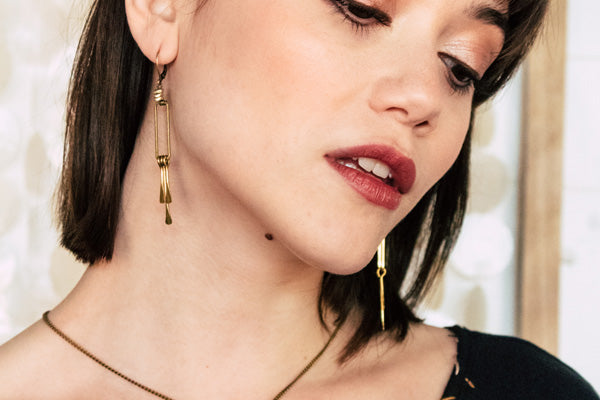A Buyer's Guide to Gold Jewelry
You find a cute piece of gold-tone jewelry that looks shiny and bright. Then you wear it a few times, and notice it turning a funny shade of brown, green or grey...maybe even staining your skin. Sound familiar?
Buying gold jewelry can be confusing experience, for good reason! Most brands would rather not give you the full story behind their materials, and don't set realistic expectations when you buy. The price tag alone isn't great proxy for quality - you need to know what you’re looking for, and ask the right questions.
Of course, the best quality gold jewelry is fine solid gold...but what about the more affordable options like gold plate, gold vermeil, gold fill, and brass?
Let's break down the basics of shopping for gold jewelry, so you'll know how to quickly identify quality pieces that won't turn your skin green!

Bottom-of-the-Barrel: Gold Plate
If it’s not labeled at all, you can assume the gold-tone jewelry you're looking at is plated. Gold plate consists of a super thin layer of gold (usually .5 microns or .5 millionths of a meter) over a cheaper core metal like copper or nickel. Minor wear-and-tear will reveal the core underneath, which can look crummy and potentially exposes your skin to allergens.
From a sustainability perspective, gold plate gets low marks. The production process, call electroplating, usually requires lots of cyanide and other toxic chemicals.
If you're looking for a long-lasting, timeless piece to add to your gold jewelry collection, it's generally best to avoid gold plate.
We do make one exception in our shop, and that's for gold-plated brass jewelry (made in a socially and environmentally responsible manner). Brass is the same color as gold, and will gradually fade to a natural-looking patina. It's easy to polish bright again or even re-plate, and the price is right for tighter budgets!

Gold Vermeil: A Step-Up in Quality
It's easy to confuse gold-plated jewelry with gold vermeil. By definition, gold vermeil always has a sterling silver base, and plating in at least 10 karat gold (scroll down to learn about karats) in a thickness of at least 2.5 microns. This means that gold vermeil jewelry lasts much longer than gold-plated.
Overall, if you want a cheaper alternative to solid gold or gold filled, but still want a high quality piece of jewelry, gold vermeil is your best choice. Although it is still subject to wear and tear over time, it can be re-plated to restore the original finish. Gold vermeil will maintain its beautiful glow for many years with proper care.

Gold Filled: The Best for Less
Gold filled jewelry is made by heat and pressure bonding a gold layer to a core made of brass, and forms a stronger bond than the electroplating process used in plated and vermeil jewelry.
Gold filled jewelry is at least 5% gold by weight - meaning it contains much more gold than plate or vermeil. The gold layer is typically 14 or 18 karats (read on to learn about karats).
With proper care, gold fill will last a lifetime - or at least several decades - without wearing down or tarnishing. It's great for people with allergies or sensitivities to cheaper base metals.
Gold fill gives you all the benefits of solid gold without the hefty price tag.
Fool’s Gold: Beautiful Pure Brass
It’s much more affordable than gold, shares the same luminous yellow tone, and with proper care it can stay bright and gorgeous for a lifetime - we’re huge fans of brass!
Brass is great if you're looking for large, statement jewelry made with big hunks of metal. What might costs thousands in solid gold can easily come in under $100 in brass.
Brass is known for its durability, malleability, and infinite recyclability. It's corrosion resistant, meaning that it doesn't tarnish as quickly as other metals of a similar value (beware of brass alloys that contain other metals like copper that tend to turn green).
Brass will darken to a bronzy "vintage" patina over time. You can clean it with warm soap and water, or use a brass polish to take it back to its full original shine.
Overall, if you’re looking for something bold and bright, with similar features to gold for a much more appealing price, brass jewelry is a great choice!
Solid Gold
Finally, if you're looking to invest in an heirloom quality piece of jewelry, then solid gold is what you want. You'll never have to worry about layers flaking off or wearing away, and you'll never need to polish it to maintain it's glow.
Though the name may be deceiving, solid gold is not 100% gold. On its own, gold is far too soft to be made into jewelry. Instead, gold is alloyed with other precious metals such as silver and base metals such as copper and zinc to make “solid gold” jewelry.
While we don't keep solid gold jewelry in-stock, you'll find many items in our shop that are available for upgrade from gold fill to solid gold, with additional lead time for production.
Karats Explained
Karats are the units used to measure the fineness of gold. “Fineness” refers to the units of gold per thousand in an alloy, or mixed metal. The finer the gold is, the higher the karat number and the more valuable it is. 24 karat gold is "pure" gold, which is too soft to be used in jewelry.
When discussing plated, vermeil, or filled jewelry, the karat number is usually describing the gold alloy in the outmost layer of the piece.
Is Rose Gold Real Gold?
Gold jewelry is always made from a gold alloy, meaning the gold is mixed with other metals. Rose gold is simply gold that's been alloyed with a higher concentration of copper instead of other metals like zinc, to give the gold a pinkish tint.
The fineness of rose gold is still measured in karats, and you can rest assured rose gold is just as precious and durable as yellow gold, and the copper content will NOT cause it to tarnish or rust.
Similarly, white gold is an allow of yellow gold with higher concentrations of nickel and zinc to create a platinum-like finish.

We hope this guide was helpful to you! Please leave a comment if you have any questions or ideas for our next blog topic!













Leave a comment